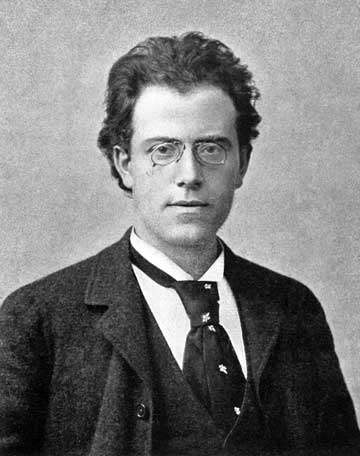Concert
Boston Symphony Orchestra
Symphony Hall, Boston
September 26, 2017
Andris Nelsons, Conductor
Symphony No. 103 in E-flat, “Drumroll”
Gustav Mahler
Symphony No. 1 in D

Around the time of the composition of his Symphony No. 1
What a delight, a week or so after the smashing Bernstein season opener, to find Nelsons keeping with the program and extracting real musical juice from the BSO.
The opening Haydn was a precision-fest, and dutifully so. Done with a somewhat larger than ordinary orchestra, it did have a dramatic weight, and the drums, which are its namesake, gave it a punctuated robustness. But, as one would expect, it is clearness and conciseness that marks much of Haydn, though the real Haydn experts – whether they be The Fine Arts Quartet or The Beaux Arts Trio – know that nuance and shape distinguish great Haydn interpreters from merely competent ones. Nelsons showed his stuff here and made precision, heft and style out of this taut piece and it was a delight.
Anticipating the dual tympani of the Mahler First Symphony, the Haydn laid the groundwork for what would be a robust and entirely fulfilling second half. Nelsons gave the Mahler not only punctuation and shape – his hallmark – but also passion and girth. He seems to be loosening his reins just enough to let the orchestral animal breathe and gallop, and indeed in this case it did. From the moddy and desolate corners f this great symphony to its lyrical heights, Nelsons carved a path for his listeners, truly pointing to the vistas while making sure that all the steps were sure-footed.
Notes on the Performances
Josef Haydn
Symphony No. 103 in E-flat, “Drumroll”
Adagio – Allegro con spirito
Starts with serious tympani followed by sonorous basses, echoed by celli and varied by violins with added syncopation. Nice emphases by Nelsons. The Allegro is light, then more substantial, with, once again, nice shaping by Nelsons. Turns eventually into a lovely dance then recapitulates. Nelsons does a good job of modulating the dance part in particular. This is a warm and robust Haydn interpretation overall. Nelsons picks up the tempo near the end but not annoyingly, ending with an extended drumroll and with basses in the same motif followed by an orchestral culmination.
Andante piu tosto Allegretto
Measured and paced. The tonality shifts in the second section to sound more major. Nice riffs by concertmaster Malcolm Lowe, followed by the other principal string players.
Menuet: Trio
Robust, within a standard and settled form. In the development section it begins to pleasantly unfold a bit.
Allegro con spirito
Beginning with the horns, then a rich underlying theme emerges more generally, pulling out the stops and bringing out the full orchestra sound.
Gustav Mahler
Symphony No. 1 in D
Langsam. Schleppend (Slow. Dragging)
Atmospheric beginning – good attenuation. Beautiful distant brass, haunting. Nice shaping in development. Delicate recap of the theme by the cellos. Picksup to a nice dancing rhythm. Incredibly deep tympani sound, then clear and coordinated cellos. Lyricism develops breaks into fabulous fanfare release. Great coordinated brass as well with vivid brass enunciation at end.
Kraftig bewegt, doch nicht zu schnell (With powerful motion, but not too fast); Trio: Recht gamachlich (pretty easygoing)
Robust waltz underneath complex interleaving rhythms. Lovely light waltz. Again the cellos carry the theme. Returns to original robust theme, with a great dramatic ending.
Feierlich und gemessen, ohne zu schleppen (solemn and measured, without dragging)
Frere Jacques theme – solo bass. Oboes take it into the horns, assisted by brass. A great Russian dance follows with a mazurka feel. Circus interlude. Good drama by Nelsons. Violins gently ever so gently raise the bucolic theme. Return of Frere Jacques, in a new key. A sped up waltz intrudes upon the scene quickly. It all fades out into nothing. A subtle heartbeat rises, then…
Sturmisch bewegt (With tempestuous motion)
Torrents! Like Night on Bald Mountain. Nice expostulation by Nelsons. Tympani followed by attenuated orchestral pauses. Lyrical development followed by torrential downpours once again. Complexity in the torrents lead to a great resolution of an heroic sort. Gruffness modulated by the violas leading to a fugue section and then a grand fanfare, building convincingly, ends the whole glorious enterprise.
– BADMan
Leave a Reply